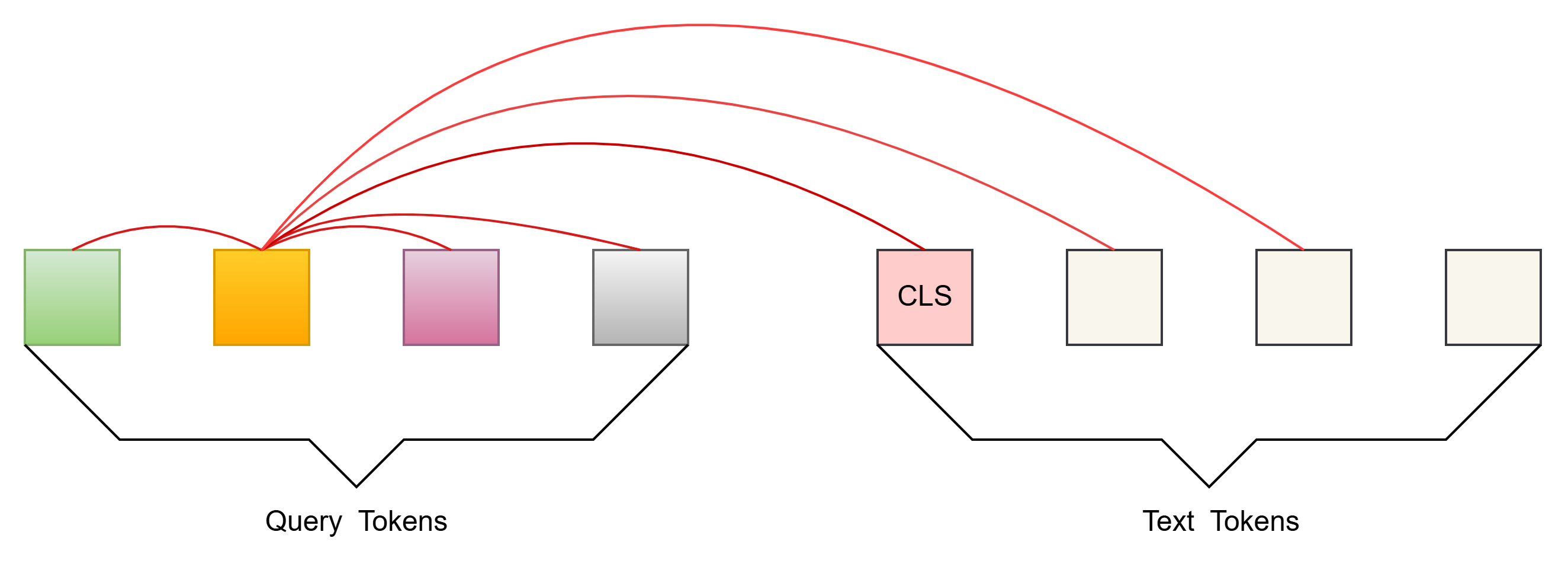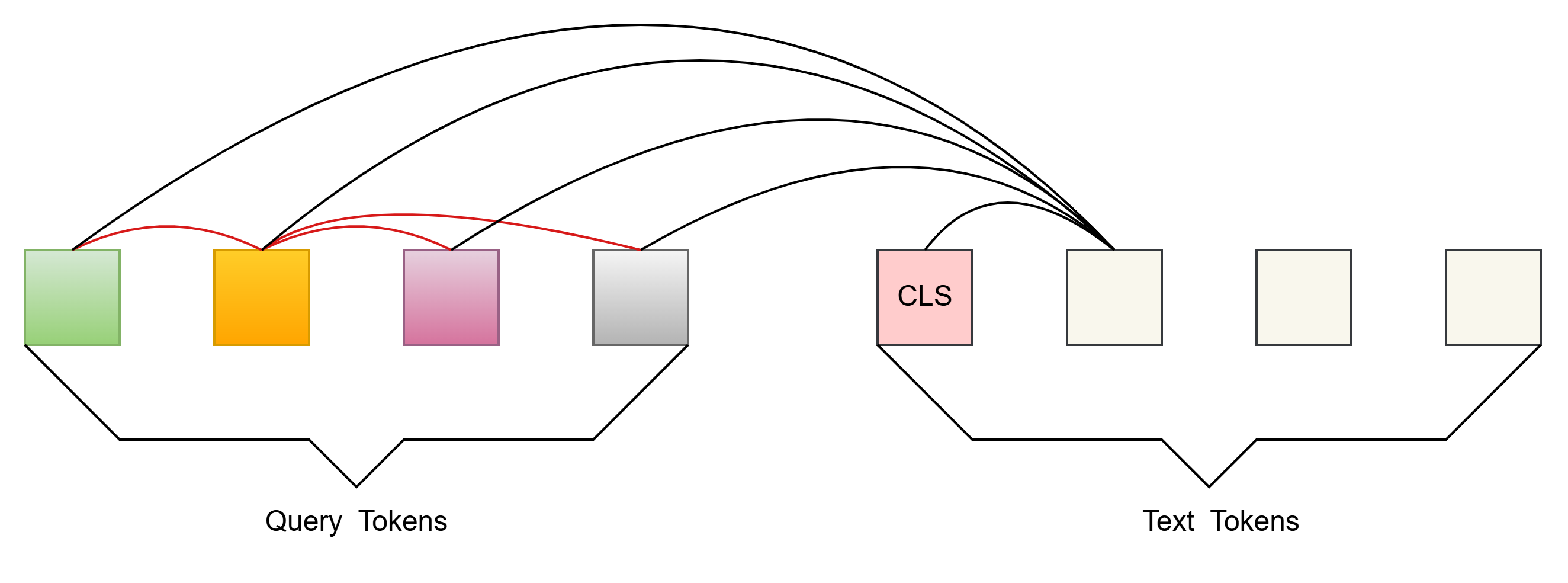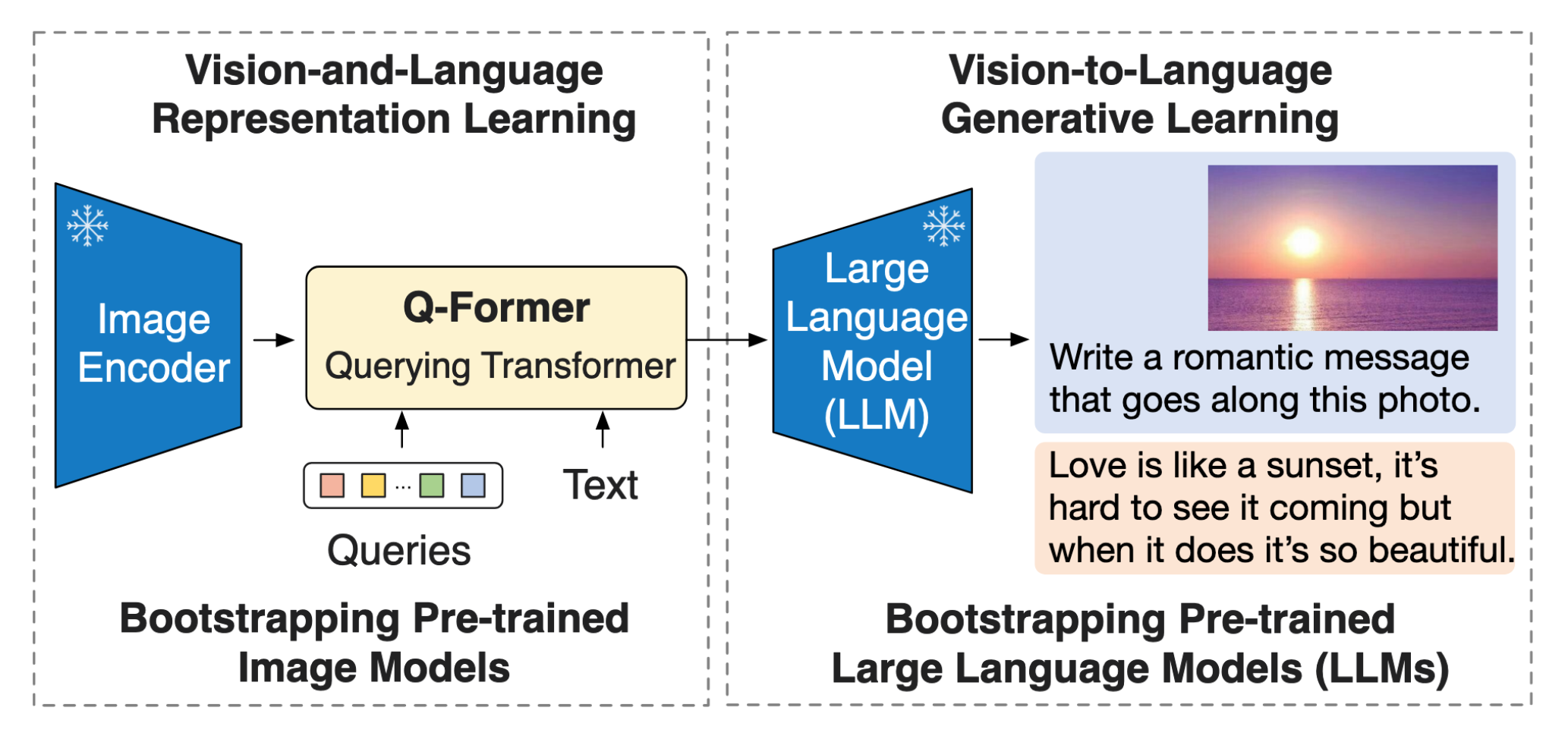
庖丁解牛BLIP2
庖丁解牛BLIP2
论文: https://arxiv.org/abs/2301.12597
代码: https://github.com/salesforce/LAVIS/tree/main/projects/blip2
背景
多模态模型在过往发展的过程中,曾有一段时期一直在追求更大的网络架构(image encoder 和 text encoder/decoder)和 数据集,从而导致更大的训练代价。例如CLIP,400M数据,需要数百个GPU训练数十天,如何降低模型训练成本,同时具有很好的性能?
这就是BLIP-2的起因,回顾下之前的多模态网络设计,三个模块(图像分支、文本分支、融合模块):

(a) 早期的图文多模态:图像分支依赖目标检测器,模态融合比较弱,如VSE++。
(b) 重点训练图像和文本特征提取,模态融合比较轻量,如CLIP。
(c) 图像特征提取和模态融合都很重。
(d) 侧重模态融合,特征提取网络相对轻量,如ViLT。
| 模块 | (a) | (b) | (c) | (d) | 理想情况 |
|---|---|---|---|---|---|
| 视觉分支 | 重 | 重 | 重 | 轻 | 重 |
| 文本分支 | 轻 | 重 | 轻 | 轻 | 重 |
| 融合模块 | 轻 | 轻 | 重 | 重 | 轻 |
| 性能 | 一般 | 好 | 好 | 一般 | 好 |
| 训练代价 | 中 | 非常高 | 非常高 | 高 | 中 |
BLIP-2 基于 BLIP 架构,利用已有的ViT 和 LLM(均冻结)+ 一个的轻量Q-Former模块做模态融合,大幅降低训练成本。具有很强的zero-shot image-to-text generation能力,同时因LLM而具有了视觉推理能力。
模型结构
BLIP-2 框架按照 Two-Stage 策略预训练轻量级查询 Transformer 以弥合模态差距。
Stage 1: 不同模态数据的提取与融合。
Stage 2: 把数据转换成LLM能识别的格式。
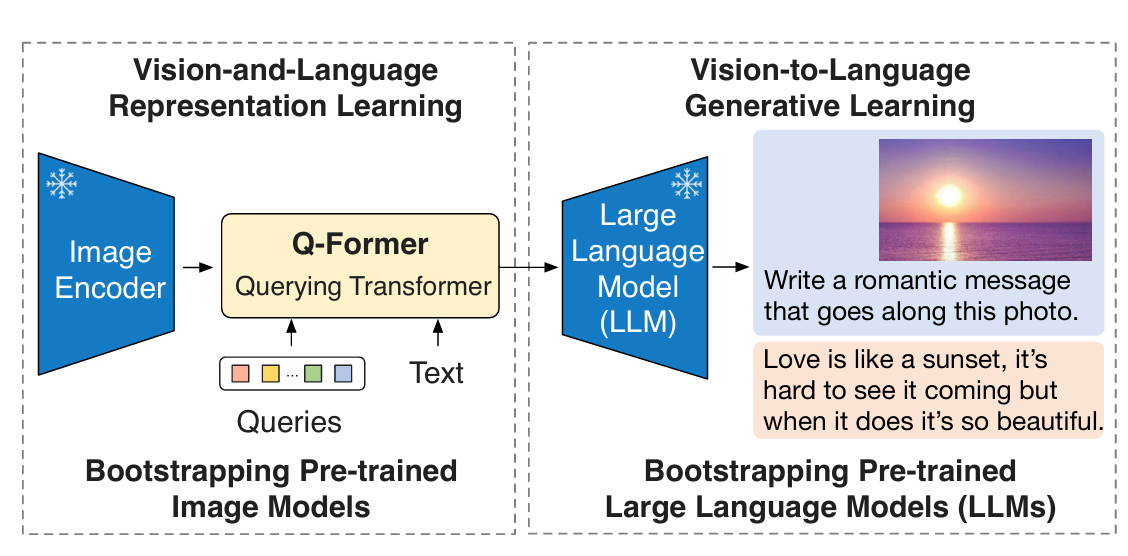
从冻结的Image Encoder引到Vision-Language表征学习。
从冻结的LLM引到Vision-Language生成学习,实现Zero Shot图文生成。
Stage 1: Representation Learning (表征学习)

Q-Former 由两个transformer模块组成,输入包含三部分:
- 冻结参数的Image Encoder提取的图像embeddings
- Learned Queries
- Queries是一组可学习的embeddings,是第一个transformer模块的input,可认为是模型参数一部分
- 推理时,Queries被用来从image encoder输出的embeddings里提取与input text最相关的视觉信息
- Input Text
Stage 1 使用 图像-文本对 进行预训练,目标是训练好 Q-Former,以便 Queries 可以学习到如何更好地结合文本提取图片信息。
对于Q-Former,一种比较好理解的方式:把Q-Former类比为一个Self-attention模块
- Q:learned queries
- K:input text
- V:image embeddings from Image Encoder
Blip2Qformer核心代码实现如下:
- 利用 query tokens 从 image embeddings 中提取与 text 最相关的视觉信息
- 将输入的 input text 进行编码 , 然后使用第一个CLS Token 作为 input text representation
class Blip2Qformer(Blip2Base):
...
def forward(self, samples):
image = samples["image"] # (B,C,H,W)
text = samples["text_input"] # (B,seq_len)
# frozen vit 将图片编码成 (B, seq_len, hidden_size)
image_embeds = self.ln_vision(self.visual_encoder(image))
# 构建padding mask标注哪些image token是有效的 (B,seq_len)
image_atts = torch.ones(image_embeds.size()[:-1], dtype=torch.long).to(
image.device
)
# 初始化query tokens (B,seq_len,hidden_size)
query_tokens = self.query_tokens.expand(image_embeds.shape[0], -1, -1)
# query tokens 从 image embeddings 中提取与 text 最相关的视觉信息
# query_output (B,seq_len,hidden_size)
query_output = self.Qformer.bert(
query_embeds=query_tokens,
encoder_hidden_states=image_embeds,
encoder_attention_mask=image_atts,
use_cache=True,
return_dict=True,
)
image_feats = F.normalize(
self.vision_proj(query_output.last_hidden_state), dim=-1
)
# 将input text 进行编码,维度为 (B,seq_len,hidden_size)
text_tokens = self.tokenizer(
text,
padding="max_length",
truncation=True,
max_length=self.max_txt_len,
return_tensors="pt",
).to(image.device)
text_output = self.Qformer.bert(
text_tokens.input_ids,
attention_mask=text_tokens.attention_mask, # padding mask
return_dict=True,
)
# 取第一个cls token作为input text representation,维度为 (B,hidden_size)
text_feat = F.normalize(
self.text_proj(text_output.last_hidden_state[:, 0, :]), dim=-1
)
...以上代码注释中统一用B代替image_batch和text_batch,以及seq_len和hidden_size也是同样处理手段,大家注意区分。
为了训练好Q-Former,第一阶段设计了三个训练目标,分别如下:
1、Image-Text Contrastive Learning (ITC Loss, CLIP-like)
目的: Image representation 与 Text representation,以最大化互信息
自注意力掩码策略: Uni-modal Self-attention Mask(单模态自注意力)
Queries 和 Text 仅能和自己的 tokens 做 attention(Query和Query、Text和Text)
Uni-modal Self-attention Mask
image_feats 中每个 image_feat 与 text_feat 计算一个 similarity score ,选择最大值作为这个图文对的相似度 :
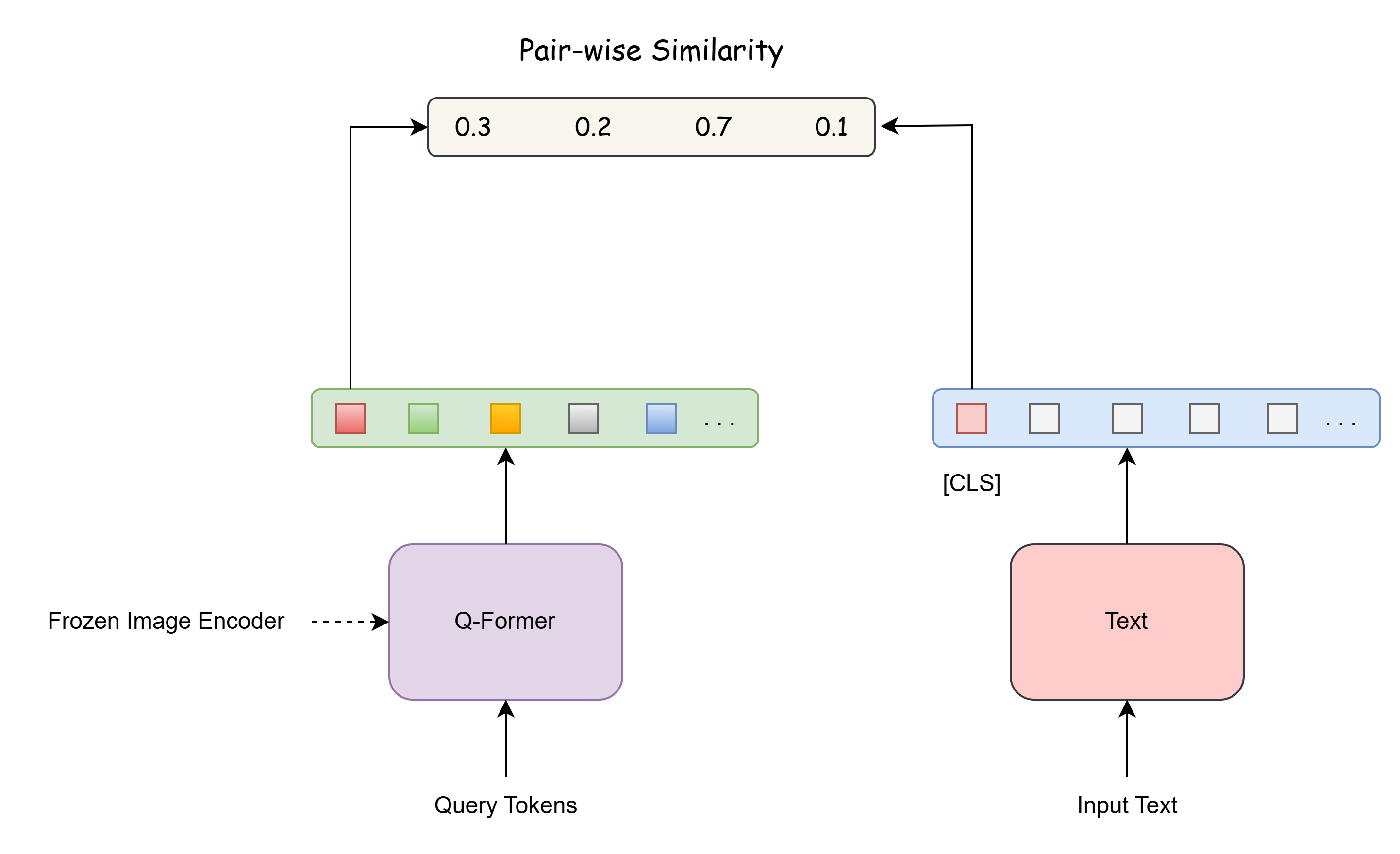
如何计算loss的: “in-batch negatives”,该方法正是CLIP在VLP领域发扬光大的。以下引用CLIP论文图做说明:
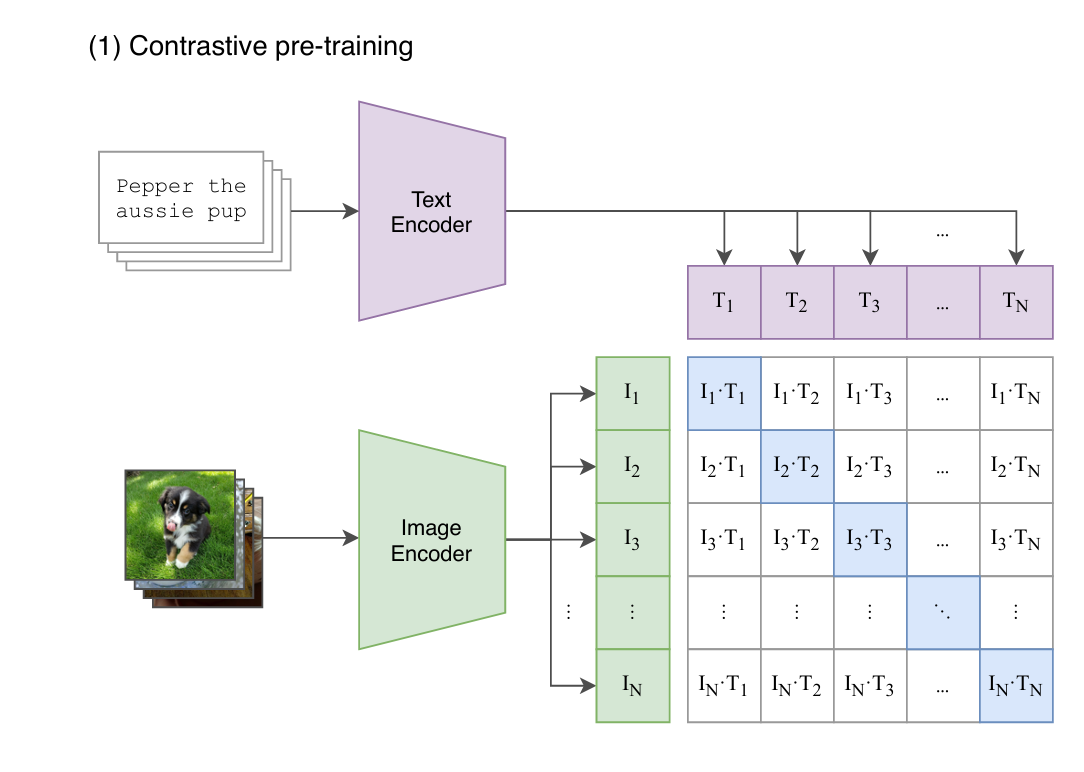
###============== Image-text Contrastive ===================###
# 计算每个query token 和 text_feat 的相似度 , 得到相似度矩阵 (B,B,seq_len)
# image_feats (B,seq_len,hidden_size) 变为 (B,1,seq_len,hidden_size)
# text_feat (B,hidden_size) 变为 (B,hidden_size,1)
sim_q2t = torch.matmul(
image_feats.unsqueeze(1), text_feat.unsqueeze(-1)
).squeeze()
# image-text similarity: aggregate across all query tokens
# 保留和text_feat相似度最大的那个query token作为最后的相似度得分 , 维度为 (B,B)
sim_i2t, _ = sim_q2t.max(-1)
sim_i2t = sim_i2t / self.temp
# 反过来计算text_feat 和 每个query token的相似度 , 得到相似度矩阵 (B,B,seq_len)
# image_feats 维度变为 (B,hidden_size,seq_len)
# text_feat (B,hidden_size) 变为 (B,1,1,hidden_size)
sim_t2q = torch.matmul(
text_feat.unsqueeze(1).unsqueeze(1), image_feats.permute(0, 2, 1)
).squeeze()
# text-image similarity: aggregate across all query tokens
# 保留和text_feat相似度最大的那个query token作为最后的相似度得分 , 维度为 (B,B)
sim_t2i, _ = sim_t2q.max(-1)
sim_t2i = sim_t2i / self.temp
# 生成比标签
targets = torch.arange(image.size(0), device=image.device)
# 计算 图文对比 Loss
loss_itc = (
# sim_i2t 形状是 (B, B),每一行表示一张图像和所有文本之间的相似度。
F.cross_entropy(sim_i2t, targets, label_smoothing=0.1) + F.cross_entropy(sim_t2i, targets, label_smoothing=0.1)
) / 22、Image-Text Matching (ITM Loss,二分类task)
目的:通过学习image-text pair是否match,以细粒度对齐 Image representation 与 Text representation
自注意力掩码策略: Bi-directional Self-attention Mask(双向自注意力)
Queries 和Text都能和所有的tokens 做attention
Bi-directional Self-attention Mask
每个output query embedding送到二分类器中,得到一个logit;所有logits的平均作为最终的matching score:
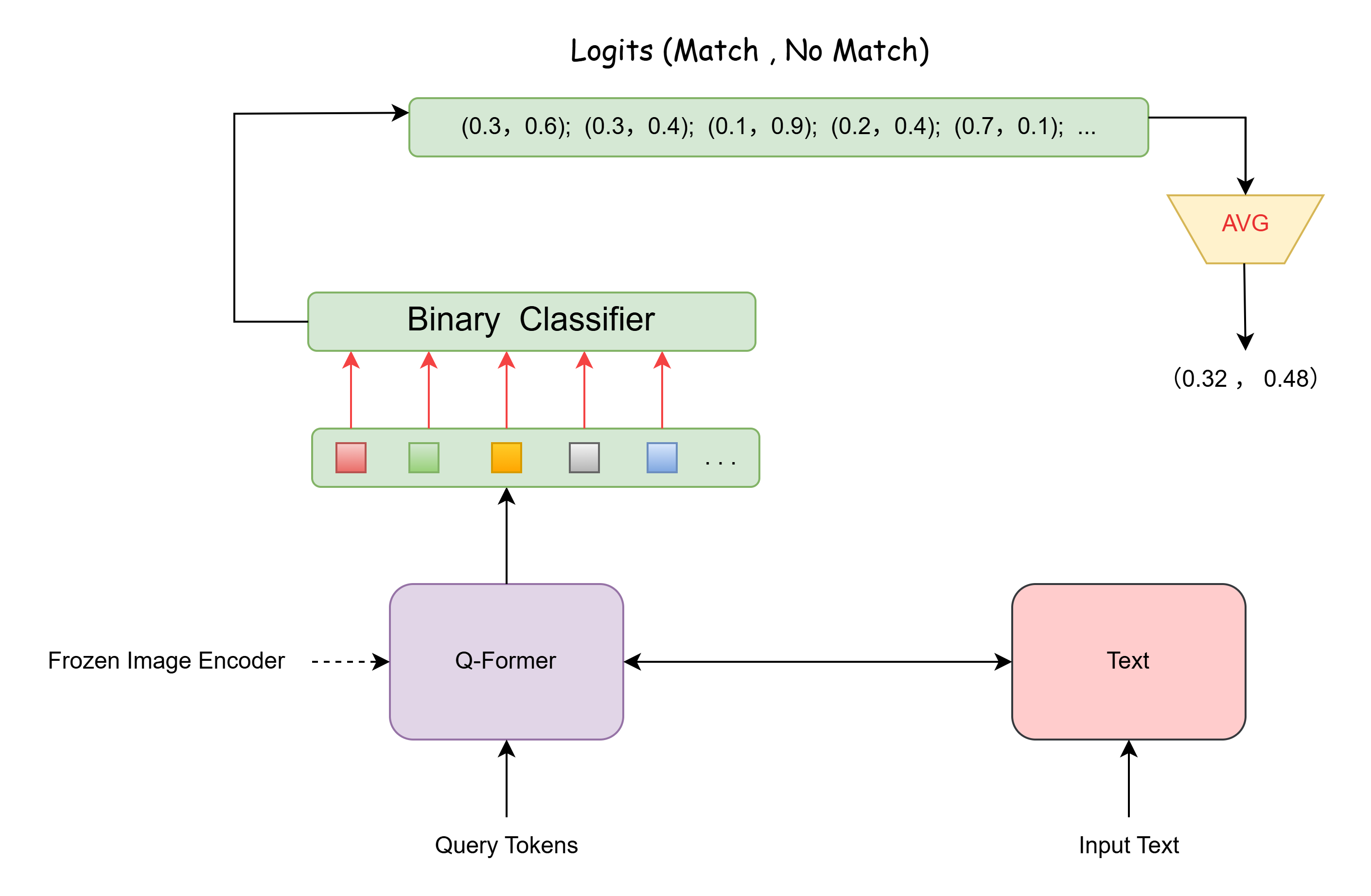
###============== Image-text Matching ===================###
text_input_ids_world = text_tokens.input_ids
text_attention_mask_world = text_tokens.attention_mask
image_embeds_world = image_embeds
with torch.no_grad():
# bs (batch size) , diag_indices = [0,1,2,...,bs-1]
diag_indices = torch.arange(bs, device=sim_t2i.device)
# 把相似度矩阵对角线元素置为负无穷大,以避免模型将匹配图文对挑选为负样本
# (0,0) , (1,1) ... (bs-1,bs-1) 位置处设置为 -10000
sim_t2i[diag_indices, diag_indices] = -10000
sim_i2t[diag_indices, diag_indices] = -10000
weights_t2i = F.softmax(sim_t2i, dim=1)
weights_i2t = F.softmax(sim_i2t, dim=1)
# 为每个文本选择一个负样本图像
image_embeds_neg = []
for b in range(bs):
neg_idx = torch.multinomial(weights_t2i[b], 1).item()
image_embeds_neg.append(image_embeds_world[neg_idx])
image_embeds_neg = torch.stack(image_embeds_neg, dim=0)
# 为每个图像选择一个负样本文本
text_ids_neg = []
text_atts_neg = []
for b in range(bs):
neg_idx = torch.multinomial(weights_i2t[b], 1).item()
text_ids_neg.append(text_input_ids_world[neg_idx])
text_atts_neg.append(text_attention_mask_world[neg_idx])
text_ids_neg = torch.stack(text_ids_neg, dim=0)
text_atts_neg = torch.stack(text_atts_neg, dim=0)
# 构建输入文本列表: [正样本batch,负样本batch1,负样本batch2] ,维度为 (3*bs,seq_len)
text_ids_all = torch.cat(
[text_tokens.input_ids, text_tokens.input_ids, text_ids_neg], dim=0
)
text_atts_all = torch.cat(
[text_tokens.attention_mask, text_tokens.attention_mask, text_atts_neg],
dim=0,
)
# 构建query tokens列表: [正样本batch,负样本batch1,负样本batch2] ,维度为 (3*bs,seq_len,hidden_size)
query_tokens_itm = self.query_tokens.expand(text_ids_all.shape[0], -1, -1)
query_atts_itm = torch.ones(query_tokens_itm.size()[:-1], dtype=torch.long).to(
image.device
)
# 构建query和text的padding mask ,维度为 (3*bs,seq_len)
attention_mask_all = torch.cat([query_atts_itm, text_atts_all], dim=1)
# 构建输入图像列表: [正样本batch,负样本batch1,负样本batch2] ,维度为 (3*bs,seq_len,hidden_size)
image_embeds_all = torch.cat(
[image_embeds, image_embeds_neg, image_embeds], dim=0
)
image_atts_all = torch.ones(image_embeds_all.size()[:-1], dtype=torch.long).to(
image.device
)
# 1. 将输入文本转换为嵌入列表后和query tokens 在seq_len维度上拼接起来,维度为 (3*bs,text_seq_len + query_tokens_seq_len,hidden_size)
# 2. 将文本和query tokens拼接得到的结果和图像嵌入进行cross attention计算,编码后得到输出的结果
output_itm = self.Qformer.bert(
text_ids_all,
query_embeds=query_tokens_itm,
attention_mask=attention_mask_all,
encoder_hidden_states=image_embeds_all,
encoder_attention_mask=image_atts_all,
return_dict=True,
)
# 取 (3*bs,text_seq_len + query_tokens_seq_len,hidden_size) 中 query tokens部分的结果,维度为 (3*bs,query_tokens_seq_len,hidden_size)
vl_embeddings = output_itm.last_hidden_state[:, : query_tokens_itm.size(1), :]
# 把query tokens部分的每个位置都映射到2维匹配空间,维度为 (3*bs,query_tokens_seq_len,2)
vl_output = self.itm_head(vl_embeddings)
# 取每个位置的平均作为最终的匹配得分,维度为 (3*bs,2)
logits = vl_output.mean(dim=1)
# 构建匹配标签: [正样本batch=1,负样本batch1=0,负样本batch2=0] ,维度为 (3*bs)
itm_labels = torch.cat(
[torch.ones(bs, dtype=torch.long), torch.zeros(2 * bs, dtype=torch.long)],
dim=0,
).to(image.device)
# 计算交叉熵损失
loss_itm = F.cross_entropy(logits, itm_labels)当文本和query tokens同时输入BertModel时,BertEmbeddings会将text embeddings和query tokens的embeddings在seq_len维度上拼接起来。
class BertEmbeddings(nn.Module):
...
def forward(
self,
input_ids=None,
position_ids=None,
query_embeds=None,
past_key_values_length=0,
):
# 计算序列长度
if input_ids is not None:
seq_length = input_ids.size()[1]
else:
seq_length = 0
# 如果未提供位置id,则自动生成
if position_ids is None:
position_ids = self.position_ids[
:, past_key_values_length : seq_length + past_key_values_length
].clone()
# 词嵌入与位置嵌入相加,若有query_embeds则拼接
if input_ids is not None:
embeddings = self.word_embeddings(input_ids)
if self.position_embedding_type == "absolute":
position_embeddings = self.position_embeddings(position_ids)
embeddings = embeddings + position_embeddings
if query_embeds is not None:
embeddings = torch.cat((query_embeds, embeddings), dim=1)
else:
embeddings = query_embeds
embeddings = self.LayerNorm(embeddings)
embeddings = self.dropout(embeddings)
return embeddings下图展示了 Image-Text Matching 的完整计算流程,关于BertModel的代码解析部分,将会在下文进行详细讲解:
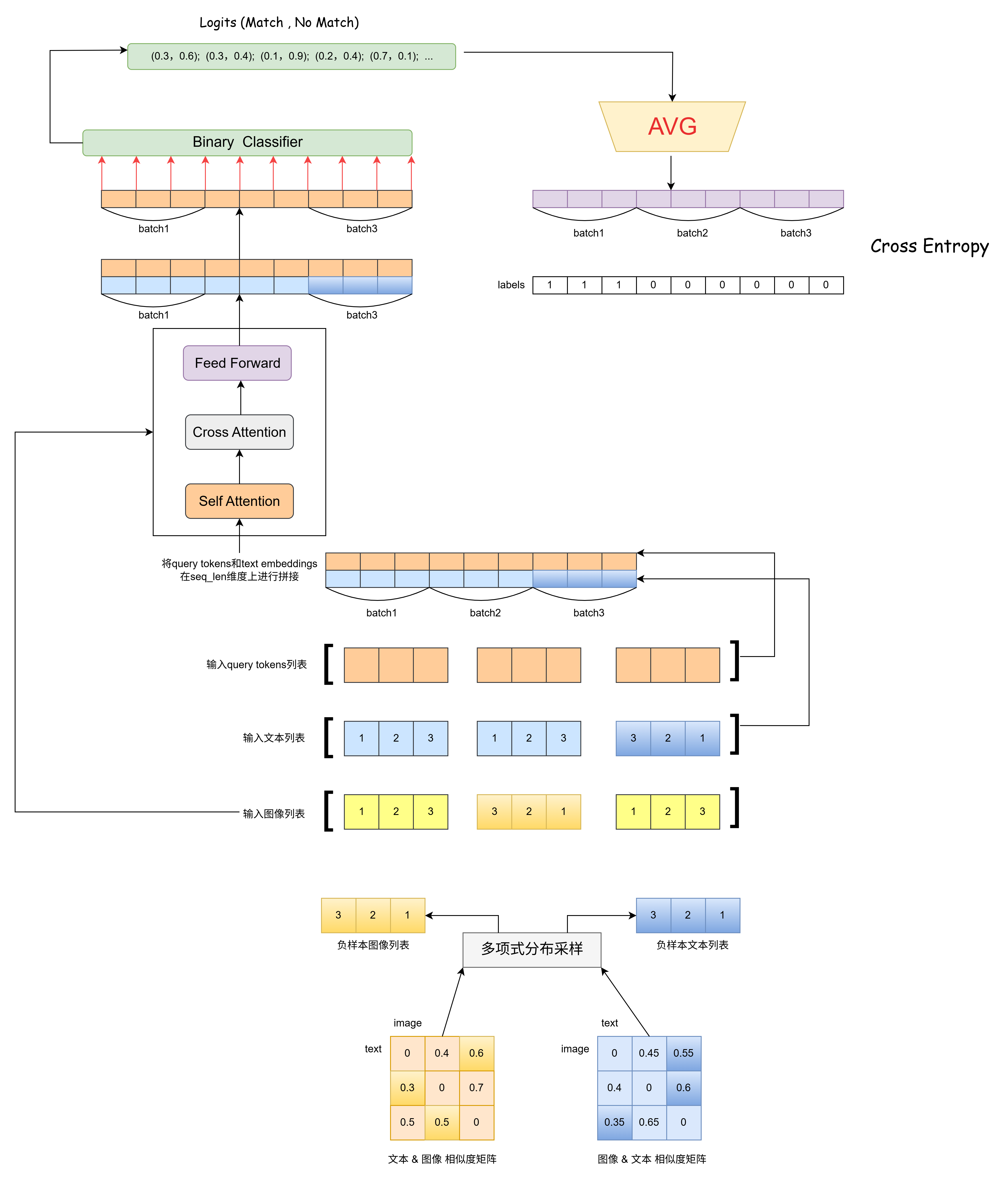
3、Image-Grounded Text Generation (ITG Loss, GPT-like)
目的:让Q-Former学习“图生文”的能力,即给定Input Image,生成Text
自注意力掩码策略:Multimodal Causal Self-attention Mask(多模态因果自监督)
Queies 可以和所有自己的tokens做attention
Text 可以和所有的query tokens 及 当前token之前的text tokens做attention
Multimodal Causal Self-attention Mask
视觉编码阶段:
图像通过视觉编码器(如 ViT)编码为图像特征 image_embeds。Query tokens 通过 cross-attention 吸收图像特征,再通过 self-attention 生成压缩的视觉表示。缓存 query tokens 的 self-attention 的 past_key_values(而非 cross-attention 的 key/value)。
QFormer 会使用 past_key_values 缓存和复用 EncoderLayer 中 self-attention 的 key/value :
- BertSelfAttention: 自注意力和交叉注意力流程统一化,每次计算后返回本次可能需要缓存的key & value
class BertSelfAttention(nn.Module):
...
def forward(
self,
hidden_states,
attention_mask=None,
head_mask=None,
encoder_hidden_states=None,
encoder_attention_mask=None,
past_key_value=None,
output_attentions=False,
):
# 判断是否为交叉注意力
is_cross_attention = encoder_hidden_states is not None
# 交叉注意力则key和value都来自图像,key来自query tokens
if is_cross_attention:
key_layer = self.transpose_for_scores(self.key(encoder_hidden_states))
value_layer = self.transpose_for_scores(self.value(encoder_hidden_states))
attention_mask = encoder_attention_mask
# 如果有缓存的key,value传入, 此时先用text embedding计算出key和value
# 再和缓存的key,value在seq_len的维度拼接起来
elif past_key_value is not None:
key_layer = self.transpose_for_scores(self.key(hidden_states))
value_layer = self.transpose_for_scores(self.value(hidden_states))
key_layer = torch.cat([past_key_value[0], key_layer], dim=2) # (Batch,Heads,Seq_len,Hidden_size)
value_layer = torch.cat([past_key_value[1], value_layer], dim=2)
else:
# 自注意力
key_layer = self.transpose_for_scores(self.key(hidden_states))
value_layer = self.transpose_for_scores(self.value(hidden_states))
# 交叉注意力: 传入图像,则q来自query tokens
# 自注意力: q来自query tokens 或者 text embedding
mixed_query_layer = self.query(hidden_states)
query_layer = self.transpose_for_scores(mixed_query_layer)
# * 缓存key和value
past_key_value = (key_layer, value_layer)
# 计算注意力分数
attention_scores = torch.matmul(query_layer, key_layer.transpose(-1, -2))
attention_scores = attention_scores / math.sqrt(self.attention_head_size)
if attention_mask is not None:
# 应用注意力掩码
attention_scores = attention_scores + attention_mask
# softmax归一化得到注意力概率
attention_probs = nn.Softmax(dim=-1)(attention_scores)
if is_cross_attention and self.save_attention:
self.save_attention_map(attention_probs)
attention_probs.register_hook(self.save_attn_gradients)
# dropout防止过拟合
attention_probs_dropped = self.dropout(attention_probs)
# 计算上下文表示
context_layer = torch.matmul(attention_probs_dropped, value_layer)
context_layer = context_layer.permute(0, 2, 1, 3).contiguous()
new_context_layer_shape = context_layer.size()[:-2] + (self.all_head_size,)
context_layer = context_layer.view(*new_context_layer_shape)
outputs = (
(context_layer, attention_probs) if output_attentions else (context_layer,)
)
# outputs 列表最后一个记录了缓存的key和value
outputs = outputs + (past_key_value,)
return outputs- BertLayer: 负责组织自注意力和交叉注意力的运算流程
class BertLayer(nn.Module):
...
def forward(
self,
hidden_states, # query tokens
attention_mask=None, # query token padding mask
head_mask=None,
encoder_hidden_states=None, # image tokens
encoder_attention_mask=None, # image padding mask
past_key_value=None,
output_attentions=False,
query_length=0,
):
self_attn_past_key_value = (
past_key_value[:2] if past_key_value is not None else None
)
# 自注意力运算
self_attention_outputs = self.attention(
hidden_states,
attention_mask,
head_mask,
output_attentions=output_attentions,
past_key_value=self_attn_past_key_value, # 缓存的key和value
)
attention_output = self_attention_outputs[0]
outputs = self_attention_outputs[1:-1]
present_key_value = self_attention_outputs[-1]
# 交叉注意力运算
if query_length > 0:
query_attention_output = attention_output[:, :query_length, :]
if self.has_cross_attention:
cross_attention_outputs = self.crossattention(
query_attention_output,
attention_mask,
head_mask,
encoder_hidden_states,
encoder_attention_mask,
output_attentions=output_attentions,
)
query_attention_output = cross_attention_outputs[0]
outputs = (
outputs + cross_attention_outputs[1:-1]
)
...
outputs = (layer_output,) + outputs
outputs = outputs + (present_key_value,) # outputs 列表最后一个记录了缓存的key和value
return outputs- BertEncoder: 负责组织多个 BertLayer 叠加的运算流程
class BertEncoder(nn.Module):
...
def forward(
self,
hidden_states, # query tokens
attention_mask=None, # query tokens padding mask
head_mask=None,
encoder_hidden_states=None, # images
encoder_attention_mask=None, # images padding mask
past_key_values=None,
use_cache=None,
output_attentions=False,
output_hidden_states=False,
return_dict=True,
query_length=0,
):
...
for i in range(self.config.num_hidden_layers):
layer_module = self.layer[i]
...
# 如果有缓存,则计算当前层BertLayer时,会从缓存中取出对应层先前缓存的key&value
past_key_value = past_key_values[i] if past_key_values is not None else None
layer_outputs = layer_module(
hidden_states,
attention_mask,
layer_head_mask,
encoder_hidden_states,
encoder_attention_mask,
past_key_value,
output_attentions,
query_length,
)
hidden_states = layer_outputs[0]
# 每一层BertLayer产生的key&value都会进行缓存
if use_cache:
next_decoder_cache += (layer_outputs[-1],)
...
return BaseModelOutputWithPastAndCrossAttentions(
last_hidden_state=hidden_states,
past_key_values=next_decoder_cache,
hidden_states=all_hidden_states,
attentions=all_self_attentions,
cross_attentions=all_cross_attentions,
)- Image-Grounded Text Generation 学习目标
...
query_output = self.Qformer.bert(
query_embeds=query_tokens,
encoder_hidden_states=image_embeds,
encoder_attention_mask=image_atts,
use_cache=True, # 缓存key&value
return_dict=True,
)
...
##================= Image Captioning ========================##
# 这一部分的目标是:根据图像特征,使用 Q-Former 解码器生成文本描述(caption)
# Step 1: 准备 decoder 的输入 token IDs
decoder_input_ids = text_tokens.input_ids.clone()
# 将第一个 token 替换为 BOS(Begin Of Sentence)标记,表示“开始生成句子”
decoder_input_ids[:, 0] = self.tokenizer.bos_token_id
# Step 2: 构造训练目标 labels
# 将 padding token 替换为 -100,这是 CrossEntropyLoss 默认忽略的标签值
labels = decoder_input_ids.masked_fill(
decoder_input_ids == self.tokenizer.pad_token_id, -100
)
# Step 3: 构建 attention_mask(包含 query tokens 和 文本 token 的 mask)
# query_atts 是 query tokens 的 attention mask,全为 1(因为都是有效 token)
query_atts = torch.ones(query_tokens.size()[:-1], dtype=torch.long).to(image.device)
# 将 query token 的 mask 和文本 token 的 mask 拼接在一起
attention_mask = torch.cat([query_atts, text_tokens.attention_mask], dim=1)
# Step 4: 调用 Q-Former 解码器进行文本生成
lm_output = self.Qformer(
decoder_input_ids, # 输入 token ID 序列(如 [BOS], dog, is...)
attention_mask=attention_mask, # 指明哪些位置是有效的(非 padding)
past_key_values=query_output.past_key_values, # 编码器输出的 key/value,包含图像信息
return_dict=True, # 返回字典格式结果
labels=labels, # 训练目标,用于计算 loss
)
# Step 5: 提取语言模型损失
loss_lm = lm_output.loss # 使用交叉熵损失衡量生成与真实之间的差异文本生成阶段:
将缓存的 past_key_values 作为文本解码器的初始状态。
文本 token 在自回归生成时,通过 self-attention 复用缓存的视觉信息。
- BertLMHeadModel: 自回归语言建模任务(如文本生成)
class BertLMHeadModel(BertPreTrainedModel):
...
def forward(
self,
input_ids=None,
attention_mask=None,
position_ids=None,
head_mask=None,
query_embeds=None,
encoder_hidden_states=None,
encoder_attention_mask=None,
labels=None,
past_key_values=None,
use_cache=True,
output_attentions=None,
output_hidden_states=None,
return_dict=None,
return_logits=False,
is_decoder=True,
reduction="mean",
):
...
# 调用 BertModel 进行文本编码 (结合缓存的attention key&value)
outputs = self.bert(
input_ids,
attention_mask=attention_mask,
position_ids=position_ids,
head_mask=head_mask,
query_embeds=query_embeds,
encoder_hidden_states=encoder_hidden_states,
encoder_attention_mask=encoder_attention_mask,
past_key_values=past_key_values,
use_cache=use_cache,
output_attentions=output_attentions,
output_hidden_states=output_hidden_states,
return_dict=return_dict,
is_decoder=is_decoder,
)
sequence_output = outputs[0]
...
# self.cls 是一个分类头(BertOnlyMLMHead),它将每个 token 的向量映射到词汇表空间(logits)
prediction_scores = self.cls(sequence_output)
...
lm_loss = None
if labels is not None:
# 因为我们要预测下一个 token,所以把 logits 和 labels 错位对齐:
# shifted_prediction_scores: 所有 token 的预测(除了最后一个)
shifted_prediction_scores = prediction_scores[:, :-1, :].contiguous()
# labels: 所有 token 的真实值(从第二个开始)
labels = labels[:, 1:].contiguous()
loss_fct = CrossEntropyLoss(reduction=reduction, label_smoothing=0.1)
lm_loss = loss_fct(
shifted_prediction_scores.view(-1, self.config.vocab_size),
labels.view(-1),
)
if reduction == "none":
lm_loss = lm_loss.view(prediction_scores.size(0), -1).sum(1)
...
return CausalLMOutputWithCrossAttentions(
loss=lm_loss,
logits=prediction_scores,
past_key_values=outputs.past_key_values,
hidden_states=outputs.hidden_states,
attentions=outputs.attentions,
cross_attentions=outputs.cross_attentions,
)BertModel 的 forward 方法中,当is_decoder=True时,会在get_extended_attention_mask方法中,构建一个下三角矩阵作为因果掩码矩阵。
Stage 2: Generative Learning(生成学习)
Stage 2 是为了把 Q-Former 和冻结参数的 LLM 连接起来,以利用 LLM 的文本生成能力。
支持两种LLM(decoder only、encoder-decoder based):

首先输入图片,直接输入冻结参数的 Image Encoder,得到图像的表征。
然后图像的表征和 Queries 一起送入 Q-Former,得到 Queries 的输出
后将投影后的
由于 Q-Former 已经过预训练以提取语言信息视觉表示,因此它有效地充当信息瓶颈,将最有用的信息提供给 LLM,同时删除不相关的视觉信息。这减少了LLM学习视觉语言对齐的负担,从而缓解了灾难性的遗忘问题。
Blip2Qformer 的generate方法负责完成图像描述生成(图文到文本):
class Blip2Qformer(Blip2Base):
...
def generate(
self,
samples, # 输入样本,包含图像和可选文本
use_nucleus_sampling=False, # 是否使用核采样(top-p采样)
num_beams=3, # beam search的beam数量
max_length=30, # 生成文本的最大长度
min_length=10, # 生成文本的最小长度
top_p=0.9, # 核采样的概率阈值
repetition_penalty=1.0, # 重复惩罚系数
):
# 1. 图像编码阶段
image = samples["image"]
# 通过视觉编码器(如ViT)提取图像特征 (B, 257, D)
image_embeds = self.ln_vision(self.visual_encoder(image))
# 2. 处理beam search扩展
if not use_nucleus_sampling:
# 如果是beam search,需要复制图像特征以匹配beam数量
# (B, 257, D) -> (B*num_beams, 257, D)
image_embeds = image_embeds.repeat_interleave(num_beams, dim=0)
else:
# 核采样时不扩展beam
num_beams = 1
# 创建图像注意力掩码(全1,表示所有图像token有效)
image_atts = torch.ones(image_embeds.size()[:-1], dtype=torch.long).to(
image.device
)
# 3. 准备生成参数
model_kwargs = {
"encoder_hidden_states": image_embeds, # 图像特征作为cross-attention的输入
"encoder_attention_mask": image_atts, # 图像注意力掩码
}
# 4. 初始化文本输入(以BOS token开头)
# 形状: (batch_size, 1),初始为[BOS]
input_ids = (
torch.LongTensor(image.size(0), 1)
.fill_(self.tokenizer.bos_token_id)
.to(image.device)
)
# 5. 扩展可学习的query tokens
# query_tokens形状: (batch_size, num_query_tokens, D)
query_tokens = self.query_tokens.expand(image_embeds.shape[0], -1, -1)
# 6. 调用Q-Former的生成方法
outputs = self.Qformer.generate(
input_ids=input_ids, # 初始文本token [BOS]
query_embeds=query_tokens, # 可学习query tokens
max_length=max_length, # 最大生成长度
min_length=min_length, # 最小生成长度
num_beams=num_beams, # beam数量
do_sample=use_nucleus_sampling, # 是否采样
top_p=top_p, # 核采样参数
eos_token_id=self.tokenizer.sep_token_id, # 结束符
pad_token_id=self.tokenizer.pad_token_id, # 填充符
**model_kwargs # 图像特征和掩码
)
# 7. 解码生成的token id为文本
captions = self.tokenizer.batch_decode(outputs, skip_special_tokens=True)
return captions

